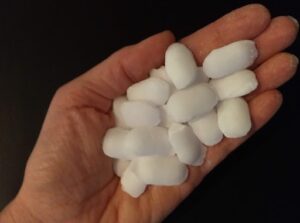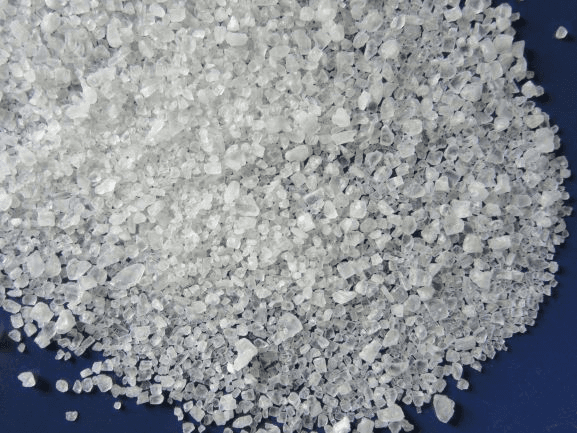We often get the question “What kind of salt do I need for my water system?”
The answer varies depending on the incoming water quality and depending on the type of water system you have. Depending on your water quality, you may see benefits from certain salts that justify the additional cost while other options may cost 5 times as much and provide no benefit to you. Also, some options are more likely to bridge and can be a hassle with little upside. Bridging refers to when the salt dissolves and undissolves in the brine tank to form one large chunk.
We keep water softener salt and potassium in stock in our warehouse at 245 Vine St. Reno, NV 89503. We also offer delivery and fill services on the service months depending on your geographic location in Reno, Sparks, Carson City, Dayton, Gardnerville, Minden, Fernley, Fallon, Truckee, and Lake Tahoe.
Depending on where you live, there are many convenient locations that sell water softener salts including: Home Depot, Lowes, Ace Hardware, Kruse’s Feed, Sierra Feed, Western Big R, Smith’s, Walmart, and Raley’s.

How Much Salt Do I Put In?
Water systems use a preset amount of salt no matter how much salt is in the tank. For example, 2 gallons of water will only dissolve 6 lbs of salt before becoming a saturated solution. So, if your system needs 6 lbs of salt to clean itself, the unit automatically puts 2 gallons of water in the brine tank before regenerating.
For this reason, we tell people to treat the salt tank like the gas tank in your car. Don’t let it run completely out, but when it’s low you can fill it back up and forget about it for a while. The exception to this rule is the additive pellets and potassium. Because these salts have a tendency to bridge, you may only want to put in a couple bags at a time. If your water use is high enough or your water quality is bad enough it may not matter because you go through enough salt fast enough that it won’t bridge. However, if you only go through 4 bags per year and you want to use the additive pellets or potassium, it is better to put in 2 bags twice per year than 4 bags once per year.
What is Bridging?
Bridging refers to the salt becoming one large chunk that the water can’t get to and dissolve so your water system stops going through salt and your water quality deteriorates. Bridging occurs more in older system that leave water in the brine tank all of the time. Newer water systems only put water in the brine tank on the night before a regeneration so the salt doesn’t have much time to turn into a chunk. Bridging is also more common when temperature fluctuates a lot. Certain areas with outdoor installations dissolve more salt when it’s hot out and the salt precipitates when the temperatures drop forming a big chunk of salt. In our area, most installations are completed in insulated garages that have consistent temperatures and less potential for bridging. It is also good practice when adding salt to stir and break up any remaining salt in the brine tank. A broom handle or short length of pvc pipe are great tools to bust up what’s left and prevent bridging.
The different types of water softener salt available are as follows:
Solar Salt
Pure sodium chloride (NaCl) in a crystal form.
The name solar salt is derived from the way the salts are formed. Saline solutions are flooded onto a salt flat. The sun then dries out the solution allowing all water to evaporate leaving behind the NaCl crystals which are then scooped up and run through the salt plant to create a uniform size crystal and bag the product for resale.
This type of salt is best for most of our customers because they are on city water that doesn’t have any iron or manganese that requires cleaning agents. The solar salt is inexpensive and you can fill your brine tank up because it doesn’t bridge as easily. Many of our customers only have to add 200 lbs of solar salt once per year!
Benefits of solar salt:
- less prone to bridging
- lowest cost option
- most noticeable silky feel
Additive Pellets
 NaCl in a ground form pressed into uniform pellets with additives to clean the resin bed. Water softener pellets take the solar salt option and add cleaners to remove things NaCl alone won’t clean from the water softener’s resin. This includes contaminants like iron and manganese. This can be beneficial if you are on a well because your water softener likely sees small amounts of iron on occasion. However, we have found that the binding agent that is added to form the pellets increases the occurrence of bridging.
NaCl in a ground form pressed into uniform pellets with additives to clean the resin bed. Water softener pellets take the solar salt option and add cleaners to remove things NaCl alone won’t clean from the water softener’s resin. This includes contaminants like iron and manganese. This can be beneficial if you are on a well because your water softener likely sees small amounts of iron on occasion. However, we have found that the binding agent that is added to form the pellets increases the occurrence of bridging.
Furthermore, the cleaning agents in the pellet salt can harm certain water treatment units. For example, our Evolve & Water Right Sanitizer units use a zeolite-based resin called Crystal-Right (CR100 & CR200). Crystal-Right is designed to remove iron and manganese and the cleaners in the pellet salt will actually degenerate the media over time.
Benefits of Salt pellets with cleaning additives:
- Protects water softener resins from fouling contaminants
Potassium
Potassium chloride (KCl) in a crystal form. A common misconception we hear is “I don’t want salt so I use potassium.” Salt is any type of chloride, so potassium chloride is still considered salt. What most people mean is they don’t want sodium, so they use potassium. In that circumstance, potassium is a great option.
We have seen a few people switch to potassium because they had the regenerant drain water of their softener running outside and wanted to water plants with it. Their thought process was “salt is bad for plants, so I’ll switch to potassium and then I can water my plants with my softener’s drain water.” Because both sodium and potassium for water softeners leave a chloride ion in the drain water, they will both kill plants and the drain water from a water softener should not be used to irrigate.
In the service water, potassium generally has less of a slippery feel. This is because bicarbonates will combine with the sodium ions and form sodium bicarbonate (baking soda). Water softeners will still have a silky feel when using potassium, but the sodium bicarbonate addition is eliminated so it is less.
We also have customers tell us they like the taste of their water more when they use potassium instead of sodium. This is relative to how hard the water is because that affects how much sodium or potassium is added. Usually, the level is low enough that the human palette is hard-pressed to tell the difference between the two. However, potassium is the most common mineral added to bottled waters to improve taste so it makes sense that your water would taste better when used in your water softener.
The main drawback to potassium is the cost. Generally Costco is the best deal on potassium. They charge less than wholesale distributors do, so I’m sure it’s a loss leader for them like hot dogs and pizza. Even at Costco though, potassium is 3-4 times the cost of other water softener salts. If you’re not getting benefit, it’s definitely not worth the added cost.
Systems that definitely don’t benefit from potassium are any kind of specialized anion resins. If you have a whole house system for arsenic, nitrates, tannins, or uranium, potassium will not make a difference. Those types of systems use the chloride portion of the molecule during the ionic exchange process so putting potassium in them is quite literally sending your money down the drain!
Benefits of potassium include:
- Improved taste
- No sodium ions added to the service water
- Less slippery feel
Learn How a Water Conditioner Can Save You Over $4,500 a Year



